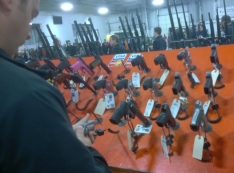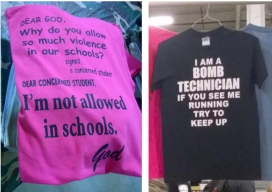The instructions were easy; the results were, I guess, to be expected.
“If you have a gun, stay to the right,” the exasperated voice repeatedly yelled. “No gun, keep moving to the left.”
 I’m sure I wasn’t the only one to pick up on the right/left, conservative/liberal, gun/no gun irony. There were many more people headed right than keeping left the morning my nephew Larry and I went to the Oaks Gun Show in suburban Philadelphia. We stayed to the left. We were gunless.
I’m sure I wasn’t the only one to pick up on the right/left, conservative/liberal, gun/no gun irony. There were many more people headed right than keeping left the morning my nephew Larry and I went to the Oaks Gun Show in suburban Philadelphia. We stayed to the left. We were gunless.
The no-gun left line was moving only slightly faster than the armed one on the right as show security officials wanted to ensure that those attendees who were packing had proper locks or other safety precautions in place for their weapons.
A couple in front of us in the gun free line had a young girl with them who was maybe eight or nine. She was cute as a button with a blonde ponytail reaching about halfway down her back; it was sticking out from a small camouflage National Rifle Association baseball cap perched on her head.
The male adult with the girl was wearing a black t-shirt bearing a large image of Phil Robertson’s head and beard and the words “Happy, Happy, Happy.” I assume this is a catchphrase on the Duck Dynasty television show. I have not yet caught an episode, so I wasn’t really sure.
Larry and I were there as part of my ongoing hunting and firearms research project as I finish up my gun free school zone magazine article. Before we were even in the door — with the two gun/no gun lines, the pre-teen future NRA member and the Phil Robertson fan in front of me – I knew I was out of my element. Thankfully, I had an expert with me.
As I’ve mentioned in several earlier blogs, I’ve relied on two guys in the know to help guide me through the unfamiliar environment of gun culture – my dear friend and neighbor Rus and my nephew and golfing buddy Larry. Larry is the husband of my wife’s brother’s youngest daughter Eva. He’s a Penn State engineering graduate and a lifelong hunter who grew up in central Pennsylvania.
We knew the show was going to be crowded as we sat in traffic for a mile and half before entering the parking lot. It was bumper-to-bumper from before the exit on Route 422, down the ramp, under the highway and back up a local road on the other side of the freeway to the exhibition center.
As we inched along, Larry explained how New Jersey’s restrictive gun ownership laws did not make it profitable for gun shows to be held in the Garden State. The waiting period in New Jersey can be as long as 30 days; in Pennsylvania, as we would learn once we finally got inside, people were filling out forms, paying their money and walking out with weapons.
“Keep moving. Ammunition? Keep to the right; same as guns,” we heard Mr. Frustrated yell once again as we finally remitted our $12 admission fee – Larry refused to let me pay (I would pick up lunch later in the day) – and we were in.
As I was out of my element, and really didn’t want a confrontation – this is a gun show, for goodness sake! – I tried to be as unobtrusive as I could, both taking notes and taking photographs. One shot I had to get was of the stacks and stacks of gun signs on tables just past the entry foyer. Two of my favorites were: “We do not dial 9-1-1, we have 9mm” and “If you can read this, you are in range.”
An elderly man walking determinedly with a cane passed by us as we entered the main hall. He had a rifle with a long carrying strap flung over his shoulder with a little white paper sign taped to a long dowel sticking out of the barrel. The sign read “$350 or b.o.” Larry explained that it was an older, probably collectable, Remington long rifle that the man had brought to the show to sell. He was not the only private gun vendor we saw hawking his wares that morning.
The main exhibition hall was immense, but it was only one of four rooms of about the same size that were filled, almost shoulder to shoulder, with gun enthusiasts, hopeful owners and the curious. There were pistols, rifles, shotguns and accessories as far as you could see. The crowd was mostly white males, but there were women and there were many more children than I expected.
What there were not that many of were African Americans. We spent about two-and-a-half hours walking up and down aisle after aisle, and I would say I saw fewer than 10 persons of color. Very surprising, considering how close we were to center city Philadelphia. I actually saw two different couples – one older, on a bit younger – several times. I found that demographically fascinating. Despite his expertise in the field, Larry was of no help on this issue.
Larry’s knowledge, however, was called into play at one of the first tables we stopped. Firearm tyro that I am, I had no idea that shotguns were produced in different lengths for different uses. The longer the barrel, Larry explained, the more accurate the weapon was at a greater distance, and the more concentrated the spread of the projectile shot pellets.
This, however, is not always the case, as he went on to show me, and explain, the concept of a shotgun choke. Having a choke at the end of your shotgun – not every shotgun comes with an adjustable choke – allows you to control the spread and accuracy of the same weapon quickly, and in the field. This, Larry explained, allows a hunter to use the same weapon to go after small, close-range game and larger, longer-range game with the same shotgun.
“Keep in mind,” he told me as he manually adjusted the choke on the sample shotgun he was holding, “you’re carrying this gun for 10, 12, 15 hours through the woods. If you can bring a shorter, lighter weapon and still use it effectively at various distances, it makes a world of difference.”
He handed me the weapon. “Imagine carrying this long, heavy shotgun for 12 hours,” he said, “either in your two hands, or over your shoulder, without ever putting it down.” It was heavy. I agreed.
While more expensive models have a greater number of choke settings, the three basic positions are full, modified and improved with average optimal ranges of 50, 30 and 25 yards, respectively.
As my nephew finished his choke talk, Bob – the vendor whose shotgun Larry was holding — came over and offered it for sale for $350. Larry replied he was in the market for a new shotgun, but said he was saving up for a new set of Ping irons. Bob laughed and said it’s tough to have two such expensive hobbies – hunting and golf – and we started talking.
Bob, who lives in Tulsa, Oklahoma, said he carts his inventory of about 200 pistols, shotguns and rifles to, roughly, 42 gun shows a year, logging about 48,000 miles annually. “It’s a living,” he said. “You meet fascinating people.” I’m sure you do, I told him as we shook hands and moved on.
Of all the different types of weapons on display and for sale, pistols were the most plentiful. They were lined up on tables, mounted to boards and kept under glass – every one of them secured with a bank-pen-like security chain. “Too easy to pocket and walk away with,” Larry explained as he aimed a bright-pink .38-caliber pistol at the ceiling.
Pink was a predominant color for the pistols that were not the standard black or silver in an obvious gesture to attract female firearm fans. There also were quite a few miniature pistols that could easily be concealed in a palm or pocket for added protection.
There were almost as many switchblades on display as there were pistols. Table after table. Surprisingly, these were not tethered in place for security, but there were a few more vendor/attendants keeping an eye on this merchandise.
Several vendors offered do-it-yourself bullet-making machines – along with scales, empty cartridge shells and bags of shotgun pellets of many varying sizes — although we did not see any actual, ready-to-fire ammunition available. I guess there are some lines that aren’t crossed, even in Pennsylvania.
Predominating the non-weapon paraphernalia for sale was quite a bit of Nazi memorabilia, including swastika arm bands. Sadly, this was not isolated to one or two tables, but was pretty much spread throughout the four exhibition halls. I realize that if people are willing to buy, other people will sell, but I would have liked to see that line not be crossed as well.
Interestingly, one of these Nazi vendors was located across the aisle from a full-size, seemingly ready-to-operate World War II medical tent. Aside the tent was an original WWII Jeep and next to that was a tank. Yes, a real tank! I thought that was the coolest part of the show. This Army gear took up an entire end of one of the halls. The WWII re-enactors told Larry and me that, just like Bob from Tulsa, they visit a number of gun shows each year, with their impressive array of materiel in tow.
A quick stop at one of the several deer jerky stands for free samples did nothing but increase our appetite, so we decided to leave and grab lunch, but not before after we took a glance at some t-shirts. A few of our favorites were: “Alcohol, tobacco and firearms should be a convenience store, not a government agency” and “Waterboarding instructor.”
It was just about 1 p.m. when we left the building and the crowds still were pouring in – “guns to the right, no guns to the left.”
# # #







